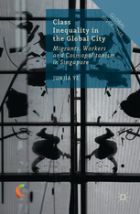Class Inequality in the Global City: Migrants, Workers and Cosmopolitanism in Singapore

Singapore has embraced its status as a global city – one with worldwide financial influence and a cosmopolitan population. Yet this status depends on the precarious livelihoods of its many migrant workers, who make up about a quarter of its residents. Stratification between the native-born and foreign-born populations complicates the city-state’s image of harmonious multiculturalism.
This book investigates how class inequality is reproduced through the same dynamics that make Singapore a so-called global city. This is one of the most unequal countries in the world, with sharp divisions between the work that local and migrant employees are willing (and allowed) to do.
Global economic currents make labour mobility crucial to Singapore’s continuing prosperity. This flexibility disproportionately benefits Singapore’s employers, and treats certain groups of workers as essentially disposable. “For example, during the recession in the late 1990s, 7,000 foreign workers had their work permits cancelled in the first five months of 1998 as compared to 6,000 cancellations in the whole of 1997” (page 53).
These inequalities are entrenched through the policies of a hierarchical and powerful state. Migrant workers are barred from purchasing flats through the Housing Development Board, which manages subsidized housing. Trade unions are tightly controlled (to the extent that Singapore has not had a strike since 1978). The Ministry of Manpower sets a maximum wage level for anyone on a work permit, and are not eligible for residency. Work permit holders are even required to gain approval by this ministry prior to marrying Singaporeans.
Ye notes, however, that the divide between local/migrant and wealthy/precarious is slippery. There is heterogeneity within the migrant worker population, with varying degrees of vulnerability and diverse cultural affiliations. Ye’s analysis looks at three groups of workers in Singapore: 1) low-paid Bangladeshi men present on temporary employment visas, 2) commuters from neighbouring Malaysia, and 3) middle-class finance workers. Category 3 is a small group with the most permissive type of employment permit, and discourse and policy clearly favour finance sector professionals over other migrant groups.
Due to Singapore’s migration restrictions, class inevitably intersects with race, nationality and gender. The Ministry of Manpower only allows people of certain nationalities to work in certain industries. This restricts domestic workers, for instance, to nationals of the Philippines, Indonesia, India, Sri Lanka and Thailand. It’s clear from Ye’s research that attention to racial difference reflects policies of difference. On one hand, the government mandates certain types of ethnic interaction: there are ethnic quotas in each housing block, and students are required to learn the “mother tongue” corresponding to their ethnicity. On the other, Ye’s interviewees report discrimination and racial tensions, and there is an ethnic imbalance across occupational categories.
Ye’s central thesis is that cosmopolitanism in Singapore does not just produce inequality; it is reliant on inequality. But she humanizes this argument through attention to individual migrants’ lives, and the ways they are shaped by, but also seek to resist, structural processes. In sum,
“I reject ideas of neoliberal conspiracy and migrant worker victimization. While much of the literature on global cities discussed the polarization of incomes and occupations, this case study expands this perspective by highlighting the fragmented socio-economic continuum that results from Singapore’s quest to maintain its status as a global city.” (page 1)
Further reading:
Environment and Urbanization (2012), “Addressing poverty and inequality – new forms of urban governance in Asia”, Vol 24, No 2, available at http://journals.sagepub.com/toc/eaua/24/2.
Hudson, Ray (2004), “Conceptualizing economies and their geographies: spaces, flows and circuits”, Progress in Human Geography Vol 28, No 4, pages 447–471, available at http://www1.geo.ntnu.edu.tw/~moise/Data/Books/Economical/04%20other/e05.pdf.
Olds, Kris and Henry Wai-Chung Yeung (2004), “Pathways to global city formation: a view from the developmental city-state of Singapore”, Review of International Political Economy Vol 11, No 3, pages 489–521, available at https://courses.nus.edu.sg/course/geoywc/publication/2004%20RIPE.pdf.
Book note prepared by Christine Ro
Search the Book notes database
Our Book notes database contains details and summaries of all the publications included in Book notes since 1993 - with details on how to obtain/download.
Use the search form above, or visit the Book notes landing page for more options and latest content.
For a searchable database for papers in Environment and Urbanization, go to http://eau.sagepub.com/

